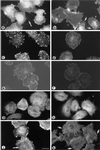Characterization of cell-matrix adhesion requirements for the formation of fascin microspikes
- PMID: 9362073
- PMCID: PMC25712
- DOI: 10.1091/mbc.8.11.2345
Characterization of cell-matrix adhesion requirements for the formation of fascin microspikes
Abstract
Cell adhesion to thrombospondin-1 (TSP-1) correlates with assembly of cell-substratum contact structures that contain fascin microspikes. In this analysis, cell-matrix requirements for assembly of fascin microspikes were examined in detail. In six cell lines, cell spreading on a TSP-1 substratum correlated with expression of fascin protein and formation of fascin microspikes. Microspikes were not formed by H9c2 cells adherent on fibronectin, vitronectin, collagen IV, or platelet factor 4. However, both fascin microspikes and focal contacts were assembled by cells adherent on laminin-1. Using mixed substrata containing different proportions of TSP-1, and fibronectin, fascin microspike formation by H9c2 and C2C12 cells was found to be reduced on substrata containing 25% fibronectin and abolished on substrata containing 75% fibronectin. Adhesion to intermediate mixtures of TSP-1 and fibronectin resulted in coassembly of fascin microspikes and focal contacts, colocalization of fascin with actin stress fiber bundles and altered distributions of beta 1 integrins, cortical alpha-actinin, and tropomyosin. In cells adherent on 50% TSP-1:50% fibronectin, GRGDSP peptide treatment decreased focal contact assembly and altered cytoskeletal organization but did not inhibit microspike assembly. Treatment with chondroitin sulfate A or p-nitrophenol beta-D-xylopyranoside decreased microspike formation and modified cytoskeletal organization but did not inhibit focal contact formation. In polarized migratory and postmitotic C2C12 cells, fascin microspikes and ruffles were localized at leading edges and TSP matrix deposition was also concentrated in this region. Depletion of matrix TSP by heparin treatment correlated with decreased microspike formation and cell motility. Thus, the balance of adhesive receptors ligated at the cell surface during initial cell-matrix attachment serves to regulate the type of substratum adhesion contact assembled and subsequent cytoskeletal organization. A role for fascin microspikes in cell motile behavior is indicated.
Figures









References
-
- Abercrombie M, Heaysman JEM, Pegrum SM. The locomotion of fibroblasts in culture I. Movements of the leading edge. Exp Cell Res. 1970a;59:393–398. - PubMed
-
- Abercrombie M, Heaysman JEM, Pegrum SM. The locomotion of fibroblasts in culture II. “Ruffling.”. Exp Cell Res. 1970b;60:437–444. - PubMed
-
- Abercrombie M, Heaysman JEM, Pegrum SM. The locomotion of fibroblasts in culture. IV. Electron microscopy of the leading lamella. Exp Cell Res. 1971;67:359–367. - PubMed
-
- Adams JC. Formation of stable microspikes containing actin and the 55kDa actin-bundling protein, fascin, is a consequence of cell adhesion to thrombospondin-1: implications for the anti-adhesive activities of thrombospondin-1. J Cell Sci. 1995;108:1977–1990. - PubMed
-
- Adams JC, Lawler J. Diverse mechanisms for cell attachment to platelet thrombospondin. J Cell Sci. 1993;104:1061–1071. - PubMed
Publication types
MeSH terms
Substances
Grants and funding
LinkOut - more resources
Full Text Sources
Other Literature Sources
Molecular Biology Databases
Miscellaneous

